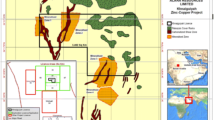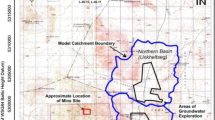Abstract
The groundwater inflow into a mine during its life and after ceasing operations is one of the most important concerns of the mining industry. This paper presents a hydrogeological assessment of the Irankuh Zn-Pb mine at 20 km south of Esfahan and 1 km northeast of Abnil in west-Central Iran. During mine excavation, the upper impervious bed of a confined aquifer was broken and water at high-pressure flowed into an open pit mine associated with the Kolahdarvazeh deposit. The inflow rates were 6.7 and 1.4 m3/s at the maximum and minimum quantities, respectively. Permeability, storage coefficient, thickness and initial head of the fully saturated confined aquifer were 3.5 × 10−4 m/s, 0.2, 30 m and 60 m, respectively. The hydraulic heads as a function of time were monitored at four observation wells in the vicinity of the pit over 19 weeks and at an observation well near a test well over 21 h. In addition, by measuring the rate of pumping out from the pit sump, at a constant head (usually equal to height of the pit floor), the real inflow rates to the pit were monitored. The main innovations of this work were to make comparison between numerical modelling using a finite element software called SEEP/W and actual data related to inflow and extend the applicability of the numerical model. This model was further used to estimate the hydraulic heads at the observation wells around the pit over 19 weeks during mining operations. Data from a pump-out test and observation wells were used for model calibration and verification. In order to evaluate the model efficiency, the modelling results of inflow quantity and hydraulic heads were compared to those from analytical solutions, as well as the field data. The mean percent error in relation to field data for the inflow quantity was 0.108. It varied between 1.16 and 1.46 for hydraulic head predictions, which are much lower values than the mean percent errors resulted from the analytical solutions (from 1.8 to 5.3 for inflow and from 2.16 to 3.5 for hydraulic head predictions). The analytical solutions underestimated the inflow compared to the numerical model for the time period of 2–19 weeks. The results presented in this paper can be used for developing an effective dewatering program.









Similar content being viewed by others
References
Aryafar, A., Doulati Ardejani, F., & Singh, R. N. (2009). Numerical modelling of groundwater inflow from a confined aquifer into Sangan open pit mine, northeast of Iran. International Journal of Geomechanics and Geoengineering, 4(3), 189–198.
Azrag E.A., Ugorets V.I., and Atkinson L.C. (1998). Use of a finite element code to model complex mine water problems. Symposium on Mine Water and Environmental Impacts. Johannesburg, 1, 31–41.
BAMA Mining Company. (2003). Detailed exploration of Irankuh district. Unpublished data of the Bama Mining, Esfahan.
Bear, J., & Cheng, A. H. D. (2010). Modeling groundwater flow and contaminant transport. London New York: Springer Dordrecht Heidelberg. 850 p.
Cooper, H. H., & Jacob, C. E. (1946). A generalized graphical method for evaluating formation constants and summarizing well field history. American Geophysics Union Transactions, 27, 526–534.
Diersch H.J.G. (2006). FEFLOW finite element subsurface flow and transport simulation system. Reference manual, WASY GmbH Institute for Water Resources Planning and Systems Research.
Domenico, P. A., & Schwartz, F. W. (1990). Groundwater simulation for the determination of post mining recharge rates at the Belle Ayr Mine. Mining Engineering, 48(11), 80–83.
Dong, D., Sun, W., & Xi, S. (2012). Optimization of mine drainage capacity using FEFLOW for the No. 14 Coal Seam of China’s Linnancang Coal Mine. Mine Water and the Environment, 31, 353–360.
Doulati Ardejani, F., Singh, R. N., Baafi, E., & Porter, I. (2003a). A finite element model to: 1. predict groundwater inflow to surface mining excavations. Mine Water and the Environment, 22(1), 31–38.
Doulati Ardejani, F., Singh, R. N., Baafi, E. Y., & Porter, I. (2003b). A finite element model to: 2. Simulate groundwater rebound problems in backfilled open cut mines. Mine Water and the Environment, 22(1), 39–44.
Esfahan Province Environmental Office (2013). Unpublished groundwater data of the Esfahan province.
Geo-slope International Limited (2012). SEEPW Software Package for finite element seepage analysis. http://www.geo-slope.com/products/seepw.asp. Accessed 5 Feb 2014.
Gray, W. G., & Pinder, G. F. (1974). Galerkin approximation of the time derivative in the finite element analysis of groundwater flow. Water Resources Research, 10(4), 821–828.
Hanna, T. M., Azrag, E. A., & Atkinson, L. C. (1994). Use of an analytical solution for preliminary estimates of groundwater inflow to a pit. Mining Engineering, 46(2), 149–152.
Hofedank, R. H. (1979). Computation of and experience on lignite opencast mine drainage (pp. 383–408). Denver, Colorado: Proceedings of the First International Mine Drainage Symposium.
Jacob, H. H., & Lohman, C. E. (1952). Non-steady flow to a well of constant drawdown in an extensive aquifer. American Geophysical Union Transactions, 33, 559–569.
Keqiang, H., Dong, G., & Xianwei, W. (2006). Mechanism of the water invasion of Gaoyang Iron mine, China and its impacts on the mine groundwater environment. Journal of Environmental Geology, 49, 1163–1172.
Kruseman G. P., & De Ridder N. A. (1979). Analysis and evaluation of pumping test data, International Institute of Land Reclamation and Improvements, The Netherlands, Bulletin 11, 60 p.
Lewis, R. L. (1999). Predicting the steady-state water quality of pit lakes. Mining Engineering, 51(10), 54–58.
Marinelli, F., & Niccoli, W. L. (2000). Simple analytical equations for estimating ground water inflow to a mine pit. Groundwater, 38(2), 311–314.
McWhorter, D. B. (1981). Predicting groundwater response to disturbance by mining-selected problems. Symposium of surface mining, hydrology, sedimentology and reclamation (pp. 89–95). Lexington: University of Kentucky.
Morton, K. L., & van Mekerk, F. A. (1993). A phased approach to mine dewatering. Mine Water and the Environment, 12, 27–33.
Reichert J., 2007. A metallogenetic model for carbonate-hosted non-sulphide zinc deposits based on observations of Mehdi Abad and Irankuh, Central and Southwestern Iran. Martin-Luther-Universität Halle-Wittenberg.
Singh, R. N., & Atkins, A. S. (1984). Application of analytical solutions to simulate some mine inflow problems in underground coal mining. International Journal of Mine Water Association, 3(4), 1–27.
Singh, R. N., & Atkins, A. S. (1985a). Application of idealized analytical techniques for prediction of mine water inflow. International Journal of Mining Engineering, 2, 131–138.
Singh, R. N., & Atkins, A. S. (1985b). Analytical techniques for the estimation of mine water inflow. International Journal of Mining Engineering, 3, 65–77.
Singh, R. N., & Reed, S. M. (1987). Estimation of pumping requirement for a surface mining operation. Symposium on pumps and pumping (pp. 1–24). England: Nottingham University.
Singh, R. N., Ngah, S. A., & Atkins, A. S. (1985). Applicability of current groundwater theories for the prediction of water inflows to surface mining excavations (pp. 553–571). Granada, Spain: Proceedings of the Second International Congress of the International Mine Water Association.
Singh, R. N., Atkins, A. S., & Doulati Ardejani, F. (2012). Hydrogeological issues concerning the Thar Lignite prospect. International Journal of Mining and Geo-Engineering (IJMGE), 46(1), 3–49.
Theis, C. V. (1935). The relationship between the lowering of the piezometric surface and the rate and duration of a discharge of a well using groundwater storage. American Geophysical Union Transactions, 16, 519–524.
Vandersluis, G. D., Straskraba, V., & Effner, S. A. (1995). Hydrogeological and geochemical aspects of lakes forming in abandoned open pit mines. Water Resources at Risk, 162–177.
Acknowledgments
The authors thank the School of Mining, College of Engineering, University of Tehran, for supporting this research. The technical support given by BAMA Company and Esfahan Province Environmental Office during the data acquisition is acknowledged. The thanks are due to University of Wollongong, NSW, Australia, for supporting this research.
Author information
Authors and Affiliations
Corresponding author
Rights and permissions
About this article
Cite this article
Bahrami, S., Doulati Ardejani, F., Aslani, S. et al. Numerical modelling of the groundwater inflow to an advancing open pit mine: Kolahdarvazeh pit, Central Iran. Environ Monit Assess 186, 8573–8585 (2014). https://doi.org/10.1007/s10661-014-4025-x
Received:
Accepted:
Published:
Issue Date:
DOI: https://doi.org/10.1007/s10661-014-4025-x




